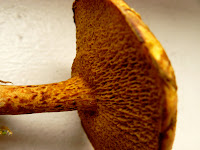 |
| Some Amanitas growing near where I live |
The Myths
1) Mushroom picking is very dangerous
Like driving a car, mushroom picking and identification are skills that are acquired by education and training. Mushroom picking skills are usually learned from other mushroom pickers like family and friends, and from good guide books. The same way I wouldn't recommend anyone to buy a car and go driving without getting a license first, I wouldn't recommend anyone to start picking whatever fungi is growing on their yard or woods and cooking them. On the other hand, if you take the time to learn it properly, both driving and mushroom picking can be very fun and useful.
2) Most wild mushrooms are poisonous.
The minority of wild mushrooms are poisonous (it is estimated by some than less than 5% are). That doesn't mean that one should approach mushroom picking without respect! One should always remember that poisonous mushrooms can be very deadly poisonous.
3) One can easily mistake a deadly mushroom for an edible one
This is usually not the case (if you take proper care) but it is what probably scares most people and makes some ask "why bother with a hobby that could be so dangerous?". The answer is, in my opinion, somewhat technical.
There are many types of mushrooms, which are broadly divided based on their reproductive organs (usually, but not necessarily, the surface under the cap). Most dangerous mushrooms have reproductive organs organized in the form of gills (like the white button mushroom you buy at the supermarket). The gills are a nice adaptation to increase surface area so that mushrooms can produce the maximum amount of spores without having to resort to gigantic caps. Unfortunately, mushrooms that looks the least dangerous (i.e. looks similar to the ones most people are used to eat) are exactly the ones beginners should avoid. Indeed, the whole idea of mushroom picking for the table is learning how to pick species that you are 100% confident about their identification (or that you can deal with the risk of mistaken it for a lookalike). This is summarized by the mushroom pickers adage "when in doubt, throw it out".
For beginners, the best strategy is to stick with species that don't have deadly lookalikes or, in other words - don't be bold (this can be summarized by the second adage "there are old or bold mushroom pickers but not bold and old mushroom pickers". For instance, if one starts with mushrooms like morels, chanterelles and puff balls (and the mushroom are properly cooked), even if a mistake is made, chances are that one is not going to die (gastrointestinal upset may happen). On the other hand if one is looking for nice looking white gilled mushrooms (or even small brown gilled mushrooms) and a mistake is made (for instance, an Agaricus is swapped for an Amanita or a Psilocybes is swapped for a Galerina), serious hepatic and renal damage (and potentially death in 10-15% of the cases) could happen.
One last note: mushroom identification is region dependent and, therefore, it is recommended that one learns how to identify the local mushrooms and that one sticks to them. Many cases of mushroom poisoning happen with immigrants because they try to apply their local knowledge/culture to other regions.
4) Mushroom picking is very hard and complex
Again, a common misconception. Mushroom picking is a very popular hobby in many parts of our planet and it is enjoyed by millions of people of all ages. Indeed, in eastern Europe and the Nordic countries, mushroom picking is probably the most popular hobby. Most of my Finnish friends know how to pick Morels and Chanterelles. Because so many people pick mushrooms, in the countries where this is a popular hobby, a culture is developed, and this is passed from generation to generation. People learn how to pick mushrooms from their parents and grand parents, and when time come, they pass it to their kids.
5) The only way to learn mushroom picking is from your family members
False again. You can join a Mycological Association near your home (that's what I did). Alternatively you can try to learn about mushroom picking by reading books (I suggest doing this very carefully if doing it exclusively) or by tagging along friends that know how to do it. Mushroom clubs exist in most capitals around the US and in many countries. They usually organize forays, seminars and other events to educate members and the general public about mushroom identification and other aspects of amateur mycology.
A non comprehensive list is below:
Mycological Associations
International
International Mycological Associations (IMA)
European Mycological Association (EMA)
African Mycological Association (AMA)
Latin American Mycological Association (ALM)
Canadian Mycological Associations
Gulf States Mycological Association (GSMYCO)
Australasian Mycological Society
British Mycological Society (BMS)
USA
North American Mycological Association (NAMA)
Mycological Association of Washington DC (MAW)
Mycological Association of New Jersey (MANJ)
Minnesota Mycological Society (MMS)
The Connecticut-Westchester Mycological Association (COMA)
Illinois Mycological Association (IMA)
Sonoma County Mycological Association (SOMA)
Maine Mycological Association (MMA)
Western Montana Mycological Association (WMMA)
Mycological Society of San Francisco (MSSF)
Wisconsin Mycological Association (WMA)
New York Mycological Society (NYMS)















